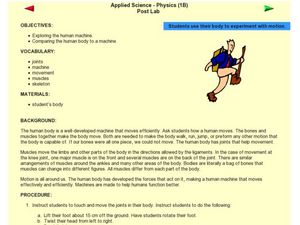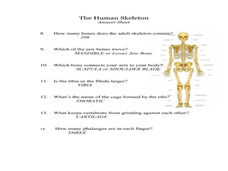Rochester Institute of Technology
Biomechanical Joint
Discuss mechanical advantage and how the human body moves/works. Learners focus on bioengineering, working together to build a functioning mechanical arm. Additionally, they analyze an air muscle, discussing its appropriate use in humans.
Purdue University
Model of Prosthetic Leg
Give the class a leg up in their understanding of engineering. A STEM activity has learners design a prosthetic leg that can kick a ball. They build a prototype of the prosthetic, keeping track of the design costs associated with their...
CK-12 Foundation
Skeletal System Joints: Appendages
The hundreds of joints in the human body fit into five main categories. A quick video explains the joints in the skeleton, which are often the most confusing. The interactive reviews each of the five types of joints and has scholars...
Nemours KidsHealth
Bones, Muscles, and Joints
What is the hip bone connected to? Learn about body parts and the human skeleton with a game of Simon Says, skeleton puzzle, and five question quiz.
Curated OER
Muscular and Skeletal Systems
How do muscles move bones? Find out using a built-in-class model. Pupils construct a hand model with paper and string, then follow a series of directions to explore the movement process. Discover additional information about the muscular...
Curated OER
Moving and Growing: Joints
Introduce the three types of joints found in the human body. Hinge, ball and socket, and sliding joints are discussed, examined, and defined in this short, yet informative presentation. There are a few pair-share opportunities suggested...
Curated OER
Moving Around
Convey the structure and function of muscles to your class with this PowerPoint. It explains how muscles are composed of bundles of cells and fibers, that there are three muscle types, and that contraction is either voluntary or...
Curated OER
Human Machine
Students explore the human body by conducting an exercise in class. In this human anatomy lesson, students view a diagram of the human body and identify the specific bones and joints that allow us to perform specific exercises like...
Curated OER
The Skeletal System
Students research the skeletal system. In this anatomy lesson, students measure their bodies to find the approximate length of their bones. They draw and cut out each of the bones and then attach them using brads or glue.
Curated OER
Skeleton
Students study the skeleton. In this human body lesson, students draw and label bones in the body by tracing each other and creating a skeleton out of body parts and brass fastners.
Curated OER
Joints Help Us Move
Third graders investigate the three main types of joints in their arms and legs that are in charge of movement. In this human biology lesson, 3rd graders view x-rays online to see how different joints look, participate in exercises that...
Curated OER
Study Guide-Skeletal System
In this skeletal system worksheet, students answer 16 questions about the functions of the skeletal system, the groups of bones that make up the skeletal system, the parts of the bones, the joints, the components of the bones and the...
Curated OER
Skeletal and Muscular System
In this muscle and skeletal system instructional activity, students complete a crossword puzzle given clues to terms related to muscles, joints, bones and connective tissue.
Curated OER
The Muscle System
In this biology worksheet, 9th graders define striated and identify if the muscles of chicken's leg are striated or smooth. Then they determine how the muscles of a chicken leg are attached to the bones. Students also cut muscles away...
Curated OER
Bone and Joint
In this health instructional activity, middle schoolers find the words that are found relating to bones and joints. The answers are found at the bottom of the page.
Curated OER
Self Acceptance
Students develop confidence about themselves. Students imagine they are a rubber ball and think about how strong they are inside themselves. They read a story about an elephant and a lion and reflect on questions provided. Finally,...
Curated OER
Fracture Fundamentals: A Cheesy Analog
Students make small cuts (fracture nuclei) in processed cheese food and then apply stresses perpendicular or parallel to the cuts to see how fractures grow. They make predictions before each experiment and explain their results to the...
Curated OER
The Leg Bone is Connected To The.... (a Look At the Skeletal System)
Students study the components of the skeletal system naming the bone groups that make up the appendicular and axial skeletal systems. They name the different layers of bone and the types of joints. They create an animated skeleton.
TED Talks
Ted: Ted Ed: Why Do Your Knuckles Pop?
Some people love the feeling of cracking their knuckles, while others cringe at the sound. But what causes that trademark pop? And is it dangerous? The following video and guide gives the facts behind joint popping. [4:22]
BioEd Online
Bio Ed Online: Arm Model
In the following lesson students are required to construct a model arm and learn how muscles and bones work together to achieve efficient movement.
Open Curriculum
Open Curriculum: The Skeletal System
After studying this article, students will be able to identify the functions and structure of bones, types of bones, bone development, parts of bones, types of joints, and bone disorders.
Other
Museum of Health Care: Joint Replacement
This is a fascinating exhibit on the history of joint replacement. According to the resource, 40,000 Canadians need a joint replaced each year. Look at some of the materials used in the past and today, how orthopedic surgeons learned...
National Institutes of Health
Nih Curriculum Supplement for Middle School: Looking Good, Feeling Good
A great resource from the Office of Science Education which provides a curriculum for teaching about the musculoskeletal system, the skin system and how they interact. This curriculum emphasizes choices teens can make to ensure good...
























